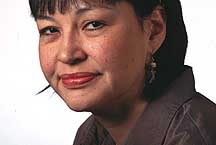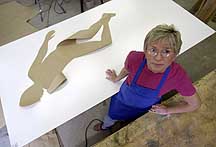Anchorage Daily News
Art of
outrage If someone hadn't raped artist Susie Silook, Grant Hall might stand
empty tonight. Instead, it will bustle with the opening of a bold art
show/happening titled "Ceremony of Healing."
Had the assault been an isolated event, the show would be a solo
exhibit. But it has drawn together a formidable sisterhood of prominent
Alaska artists, all Native women. The work explores not just the epidemic
of violence against Alaska Native women, but the attitude that discounts
them as submissive, ignorable, as drunks who deserve what they get.
Some say cultural conditioning and shame keep these women from seeking
help and telling their stories, retreating in anonymous silence that makes
them even more vulnerable to attackers.
Tonight, that anonymity ends.
"I am the stereotype," said Silook. "I am that drunken Native woman who
got sexually assaulted. It's not like I want to be the poster child -- but
let's put a face on it.
"The stopping has to start somewhere."
ONE WOMAN'S STORY
"Protective Custody" is a multimedia installation that includes police
reports and other documents concerning Silook's case.
"I was an alcoholic, in relapse for three years, in and out of trouble,
hurting people," Silook admits. "I take responsibility for that."
After one incident, she spent 10 days in jail for domestic violence. "I
share that because, too often, our shame keeps us silent."
On Sept. 19, 1999, she went drinking, blacked out and became disruptive
at an Anchorage bar. Bouncers held her on the ground in handcuffs until
police took her into protective custody.
"I woke up in a cell. The crotch of my jeans was bloody. I was in
shock. I didn't know what happened to me. My boyfriend came to get me out.
He saw the blood and was shocked, too." The responding officer and a jail
guard also noticed the blood, according to APD documents, but assumed she
was menstruating.
Silook changed into fresh clothes and threw the soiled jeans into a
trash bin in revulsion. Discarding evidence was a mistake, she says. "But
I wasn't in any condition to think."
At home the pain in her crotch became more intense. She went to the
Alaska Native Medical Center, where she was referred to the Sexual Assault
Response Team at Alaska Regional Hospital. She underwent "a horrible
exam." The crime lab report documents deep lacerations, cuts and bruises
consistent with nonconsensual sex, showing evidence of an assault with a
foreign object.
But as the investigation continued, the detective found reasons to be
skeptical. Witnesses at the bar said the crotch stains were feces. Bar
security told him they had Silook on videotape, but when the detective
viewed the tapes he couldn't find her.
Silook continues. "Finally he called me and said, 'How do I know this
wasn't consensual?' I got upset with him."
The detective wrote, "On 11-10-99, I telephoned Susie Silook and told
her I would be suspending the case. The conversation with Silook was
heated on her end," according to Anchorage Police Department documents.
The same day, the detective suspended the investigation.
Silook wrote to the Federal Bureau of Investigation, angry because
Anchorage police did not pursue the videotape or interview the bar
doorman, and because no one tried to get medical help for her after
noticing the blood. The FBI replied that her civil rights had not been
violated and her allegations were not a federal matter.
The event shook Silook into serious self-examination. She checked
herself into an alcohol treatment center and has remained sober. She
hurled herself into her work and won a $20,000 fellowship. She tried to
put the ugly memory out of her mind.
But it didn't work. "What retraumatizes us most is hearing about
continued unsolved assaults on Native women," she said.
The recent act of youths shooting Natives with paint balls on downtown
streets rankled her, not just because of its racism, but because it
received national attention not given to murdered Native women.
"No one blamed the men for being drunk. But society believes women who
are drinking -- not just Native women -- are asking for it."
And there was the uproar over a poem about Native women, and the
protest against it. Non-Natives tended to read the polarizing affair as a
freedom of speech issue; Natives, on the other hand, with near unanimity,
felt the poem crossed the line of acceptability.
"The attack on (Tlingit writer) Diane Benson when she dared to be
offended . . . was unbelievable," said Silook. "We're expected to be
shamed into our place."
Six weeks ago she heard a radio report of another assault on a Native
woman. Again, the assailant was unknown. Again, alcohol was involved.
"I was mad. Yes, alcohol was involved. But so was a whole person. You
hear all these reports, but you never hear about people going to jail for
it."
She decided to respond with an art show. For advice, she called Susie
Bevins, the most famous contemporary Native woman artist in the state.
Bevins listened, then replied, "You're the answer to my prayers."
BURIED BEADS
At first glance, Bevins seems like Silook's opposite. The soft-spoken,
60-year-old grandmother is a well-respected member of Alaska's fine art
community. Of mixed Inupiat and white parentage, she has blonde hair and
pale eyes. Her viewer-friendly sculptures decorate schools and hospitals
around the state.
But she has also tackled tough themes, as in her 1988 series "People in
Peril -- Bound by Alcohol," at the Anchorage Museum of History and Art.
"Having experienced my own demons, including addiction to alcohol and
drugs, I have strong feelings about those issues," she said.
The unsolved murders of Native women particularly stirred her. "As a
woman, it is painful to read about how these women were brutalized and
killed, discarded as trash. I have to wonder, if these were white women,
would there be more interest in solving these crimes?"
The two decided to collaborate. Inquiries flooded in from women wanting
to participate. The women wanted the public to see the show before
hearings by the Governor's Commission on Tolerance and the U.S. Commission
on Civil Rights, tentatively scheduled for this summer.
Among those joining tonight's event is the controversial Diane Benson
herself, weaver Helen McNeil, abstract artist Sonya Kelliher-Combs,
Fairbanks painter Phyllis Fast and mask-maker Dora Buchea, Silook's
sister.
Bevins has created an installation of sprawling silhouettes, like
homicide chalk outlines, set off with crime scene tape. Another piece
shows a bound man in his own casket with a black mask that cannot hide his
inner fractures. This sculpture addresses what Bevins calls "the poor men
who would do such horrific acts."
His face is blank, she said, "because he doesn't know his own identity,
he can't even see himself. I think that's what happens with mentally ill
people. They're devalued, wounded, full of rage and confusion. There are a
lot of loners out there screaming silently for help."
Benson will recite her poetry and perform a new theater piece. Former
Daily News editorial writer Martha Upicksoun will recite a personal
opinion essay. McNeil and Silook will also read from their writings.
Native women on St. Lawrence Island once ritually inserted their
troubles into the bead hole then buried the trinket to purge the problem.
The show includes a bowl of beads. Viewers are invited to add their own
beads to the collection and, at the end of the exhibit, the beads will be
interred.
But can any ceremony, poem or work of art make a difference? The
artists disagree. "Sometimes visual imagery impacts more forcefully than
words," said Bevins, who feels positive about the upcoming hearings. "I
don't know that it can change society, but it can make people think."
But, she hopes, the show will encourage others to find their voice. "I
know I'm not the only woman this has happened to."
Speaking out is a painful but necessary step for Native women to take,
said Bevins. Continued silence "hinders our ability to talk about these
serious issues," she said.
"No one's doing this to be sensational. We're doing it because things
need to change."
Mike Dunham can be reached at mdunham@adn.com.
REFER: CEREMONY OF HEALING: EXPRESSIONS CONCERNING VIOLENCE TOWARD
ALASKA NATIVE WOMEN will open with a reception and readings at 6 p.m.
today in Alaska Pacific University's Grant Hall. The art will remain on
display through June 30. Admission is free.
Native rape victim finds self-expression and healing in mixed
media![]()
By Mike
Dunham
Anchorage Daily News![]()
Had authorities identified a
suspect, Silook might not have produced work that screams out so
explosively. "All the Rage" is a fanged, howling female. Her beaded eyes
glare wildly. One raised hand holds an ulu, symbol of Eskimo womanhood;
the other flashes claws and a bloody cross. Paint balls blotch her body.

"I am the stereotype," artist Susie Silook says. "I am that
drunken Native woman who got sexually assaulted." Silook has turned
her anger into art. (Evan R. Steinhauser / Anchorage Daily
News)
Silook sees things more darkly.
"I have doubts about the civil rights hearings. I know I can forget about
justice. There'll never be any justice for me in this case."

Artist Susie Bevins is one of several Native women putting on
a show protesting violence against Alaska Native women. (Evan R.
Steinhauser / Anchorage Daily
News)